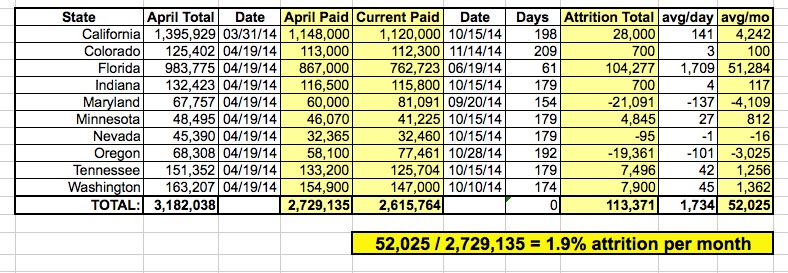Well I'll be damned. Avg. QHP attrition really IS about 2% per month!
For months now, for off-season enrollments, I've been looking at 3 major numbers: The gross additions (which I settled on being around 9,000 per day); the 1st month payment rate (which I had estimated at 90% before dropping this to about 88% a few weeks ago), and the average attrition rate (that is, how many people drop their policies after the first month).
When HHS Secretary Sylvia Burwell finally revealed that 7.3 million people were enrolled in policies as of August 15th, most of my assumptions were confirmed...except that the attrition rate, which I had been assuming was around 3% per month, now seemed to be even lower, at 2%. However, I wasn't sure about this until now.
Today I added a whole slew of updated state-level current enrollment numbers, and now I have these for 10 states, comprising nearly 3.2 million of the original 8.02 million enrollees through 4/19/14, or almost 40% of the total. This strikes me as being a pretty good base to extrapolate the other 40 states (+DC) from.
With that in mind, I went ahead and plugged all 10 into a spreadsheet, and guess what I found?

How do you like that?
I had to adjust for the different end dates by first calculating the average daily attrition, then multiplying that back out x30 to get the monthly average. Add them all up and voila...1.9% per month on average.
There's something else extremely important to note: Take a look at Florida. Then take a look at the total attrition at the bottom (both total and average). Notice anything? That's right: Florida accounts for virtually all of the attrition to date. In fact, when broken out by monthly average, you can see that if you remove Florida from the picture, there'd be a net gain of 180 enrollees per month...which is right in line with the August 15 national total (7.3 million) being higher than the number who likely paid out of the original 8.02 million enrollees (around 7.06 million).
So, why did Florida have such a huge drop in the early summer? Is it because it's a large state? No, because California enrolled 40% more people, and Washington, Tennessee & Indiana all enrolled over 130K apiece. Is it because it's a GOP-run state? No; other red states like Indiana and Tennessee had nominal drops at most. I really can't say for sure. The problem is that that large drop only runs through mid-June, while all of the other states run through September or later. My guess would be that there was a large drop-off from the original enrollment period tally, but it was cancelled out by a fairly large number of off-season enrollees from July onward. Without having a more recent tally out of FL, there's no way of knowing...and I've already confirmed that the June numbers are the most recent available for the moment.
In any event, it's certainly an outlier.
Anyway, Megan McArdle & Bob Laszewski should find this of special interest, since they've both been operating on the assumption that there's been a substantial drop-off in enrollments since the 7.3 million announcement. I'm not being snarky here; their theory wasn't an unreasonable one...I just think this new data should put it mostly to rest.
(Note: Yes, the paid percent does come in at only 85.8%, but that's because there are 13 states with confirmed payment rates not included. Adding these in brings it up to 86%; in addition, some of those rates were reported as of late April or early May, meaning up to 100,000 enrollee payments weren't even due at the time. Add the bulk of those in and you're at around 88%).



